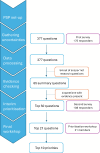Top 10 research priorities for congenital diaphragmatic hernia in Australia: James Lind Alliance Priority Setting Partnership
- PMID: 38880507
- PMCID: PMC11672073
- DOI: 10.1136/archdischild-2024-327108
Top 10 research priorities for congenital diaphragmatic hernia in Australia: James Lind Alliance Priority Setting Partnership
Abstract
Objectives: The Gaps in the Congenital Diaphragmatic Hernia (CDH) Journey Priority Setting Partnership (PSP) was developed in collaboration with CDH Australia, James Lind Alliance (JLA) and the Murdoch Children's Research Institute to identify research priorities for people with CDH, their families and healthcare workers in Australasia.
Design: Research PSP in accordance with the JLA standardised methodology.
Setting: Australian community and institutions caring for patients with CDH and their families.
Patients: CDH survivors, families of children born with CDH (including bereaved) and healthcare professionals including critical care physicians and nurses (neonatal and paediatric), obstetric, surgical, allied health professionals (physiotherapists, speech pathologists and speech therapists) and general practitioners.
Main outcome measure: Top 10 research priorities for CDH.
Results: 377 questions, from a community-based online survey, were categorised and collated into 50 research questions. Through a further prioritisation process, 21 questions were then discussed at a prioritisation workshop where they were ranked by 21 participants (CDH survivors, parents of children born with CDH (bereaved and not) and 11 multidisciplinary healthcare professionals) into their top 10 research priorities.
Conclusion: Stakeholders' involvement identified the top 10 CDH-related research questions, spanning from antenatal care to long-term functional outcomes, that should be prioritised for future research to maximise meaningful outcomes for people with CDH and their families.
Keywords: Child Development; Intensive Care Units, Neonatal; Intensive Care Units, Paediatric.
© Author(s) (or their employer(s)) 2025. Re-use permitted under CC BY. Published by BMJ Group.
Conflict of interest statement
Competing interests: None declared.
Figures
Similar articles
-
What matters to you? Engaging with children in the James Lind Alliance Children's Cancer Priority Setting Partnership.Res Involv Engagem. 2023 Nov 30;9(1):110. doi: 10.1186/s40900-023-00518-2. Res Involv Engagem. 2023. PMID: 38037183 Free PMC article.
-
Research priorities in children requiring elective surgery for conditions affecting the lower limbs: a James Lind Alliance Priority Setting Partnership.BMJ Open. 2019 Dec 30;9(12):e033233. doi: 10.1136/bmjopen-2019-033233. BMJ Open. 2019. PMID: 31892663 Free PMC article.
-
Research priorities for the most premature babies born <25 weeks' gestation: results of an international priority setting partnership.Arch Dis Child Fetal Neonatal Ed. 2025 Mar 26:fetalneonatal-2024-328133. doi: 10.1136/archdischild-2024-328133. Online ahead of print. Arch Dis Child Fetal Neonatal Ed. 2025. PMID: 39988355
-
Identifying research priorities in breast cancer surgery: a UK priority setting partnership with the James Lind Alliance.Breast Cancer Res Treat. 2023 Jan;197(1):39-49. doi: 10.1007/s10549-022-06756-4. Epub 2022 Nov 1. Breast Cancer Res Treat. 2023. PMID: 36319906 Free PMC article. Review.
-
Top ten research priorities in global burns care: findings from the James Lind Alliance Global Burns Research Priority Setting Partnership.Lancet Glob Health. 2025 Jun;13(6):e1140-e1150. doi: 10.1016/S2214-109X(25)00059-2. Epub 2025 Apr 23. Lancet Glob Health. 2025. PMID: 40286806 Review.
Cited by
-
Pulmonary T2* quantification of fetal lung status in congenital diaphragmatic hernia: future alternative to ultrasound?Pediatr Res. 2025 Jun 24. doi: 10.1038/s41390-025-04241-4. Online ahead of print. Pediatr Res. 2025. PMID: 40555780 No abstract available.
References
MeSH terms
LinkOut - more resources
Full Text Sources
Miscellaneous

